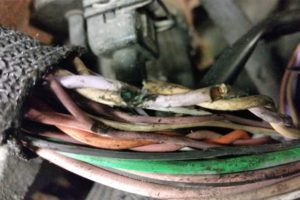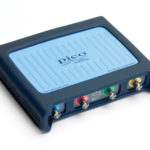Antony Powell, Yorks, tests out the Pico 4425 4 Channel Scope
Having owned a PicoScope for many years I jumped at the chance to try out the latest and improved version of the tool – the PicoScope 4425 4 channel scope – when PMM offered me the opportunity.
After taking delivery of the unit and opening the box, one of the first things I noticed was the 90 ̊ rotation of the unit and the massive selection of leads and connectors that it came with. Although this could seem a little daunting to a first time user, it won’t take long for you to work out what’s what.
Modern version
Upon connecting the unit and loading the latest software I realised that Pico has changed to a more modern (and faster) USB3 lead, whereas I’ve previously used an extended USB2 lead to a laptop that is connected to a large monitor on the wall in the workshop and a large screen laptop when I’m doing a mobile job. I’ve found that this makes things a lot easier to see (especially from the driver’s seat) and no detail is lost to a tiny image, as can sometimes be the case with hand-held scopes.
The function of an oscilloscope is fairly straightforward in that it offers the technician the chance to see an image representation of voltage versus time. Despite this concept being fairly simple, however, you’d be amazed at how many technicians still find them daunting to use. If you fall into that particular camp then the PicoScope is easy to use and understand and following the simple instructions within the software will help set the basics up for you. As with all automotive tools, the more time you spend playing with it the quicker your confidence will grow.
With the new USB lead connected and the software installation proving a breeze, the unit quickly sprung into life. We were now ready for action!
Real-life jobs
Once I started to use the unit I immediately noticed a big difference in speed when compared with my older scope (up to six times faster, according to Pico) and the images seemed much clearer at the same time – this is very important when you’re testing. The scope software was familiar to use but still had that ‘new’ feeling about it and, after toggling the easily adjusted settings and screen colours to suit my taste, I was on to my first job: a Renault Megane with intermittent non-start.
After a quick code read had revealed a DTC relating to crank sensor faults, I followed up with a simple scope set-up on to the cam and crank sensors. This promptly showed some very untidy signals from the crank sensor. When quizzing the owner before the work began I found out that he was a bit of a DIY enthusiast and that a new sensor had been fitted only three days ago, based upon his ‘Google’ diagnostics (!). “There’s been little change, so it must be something more complicated, like the ECU,” he’d said.
After taking a quick call from another customer I returned to the car to find that it had decided to become a ‘non-starter’ in my absence and the signal shown by the Pico was virtually unrecognisable. After checking the wires etc, I decided to fit a new OEM sensor and, unsurprisingly, this cured the problem, with the scope readings back to their normal consistency. It doesn’t take a brain surgeon to work out the lesson that my customer learned from this experience…
The next job that I used the tool on was a Nissan Primastar with injector issues. As we specialise in the removal of seized injectors, taking on this job held little fear for us. The 2 litre M9R engine was running sweetly as I drove it into the workshop, yet a code read revealed several individual and injector bank faults. This rang alarm bells as injector failure on these engines is something that is usually quite code-specific.
It was time to get the Pico out again and, after stripping the vehicle for access and setting up the Amps clamp, a good signal was found on cylinder #1. By this time the engine had warmed up a little and the misfire was becoming more obvious. When I moved the clamp to cylinder #2 the image became weaker and intermittent and the fault got worse, while cylinders #3 and #4 showed slightly different images, but similar faults. Having worked on thousands of these vans I was convinced that this was not an injector issue, as reported by the code reader, but a wiring issue instead.
With my prior knowledge in hand I stripped off the front end of the van to access the harness and soon found what I was looking for (see main image, top of page). The harness had broken down, allowing the wires to corrode and causing the misfire. A quick harness repair and all was well again.
These particular examples highlight one of the big advantages that an oscilloscope can bring to your diagnostic routine – by proving a fault before ordering and replacing parts you’ll be saving time and money for everyone involved. The fault codes on this van could have led a less experienced technician into swapping three of the four injectors – a very expensive job which could easily have backfired. By using the scope I was able to clearly see that the injectors weren’t at fault.
There are numerous other ways that workshops can utilise an oscilloscope – from quick and easy compression/battery testing to CAN Bus or VVT checks – and the PicoScope is a truly universal tool that fits its role and does the job perfectly.
Software updates are fairly regular and they’re also FREE over the lifetime of the tool – a very refreshing change from the chargeable updates that some manufacturers will apply. Furthermore Pico offers extensive backup and support, including a range of built-in ‘Guided Tests’, and access to its terrific waveform library from within the software (with a scope connected) – an online database from PicoScope users around the world, giving examples of ‘good’ and ‘bad’ waveforms. Users will also get regular newsletters that provide useful content and training material.
Final thoughts
After assessing the new scope for several months I have to say that I’ve been nothing but impressed with it, with the speed and memory size among the biggest improvements I noticed. If there was one improvement I’d make then it would be the ability to have separate triggers for each channel but, after broaching the subject with Pico, this doesn’t appear to be in the pipeline at the moment. Still, it’s refreshing to get an honest reply and not the usual “it’ll probably be in the next update” type answer that you get from some tool suppliers.
I’ve tried out several scopes in my own work over the years and personally think the PicoScope is right at the top of the tree in terms of value-for-money. The fact that the unit is approved and used by several of the world’s top VMs should tell you everything you need to know about the quality of the PicoScope and I’d have no hesitation in recommending it to other technicians.










